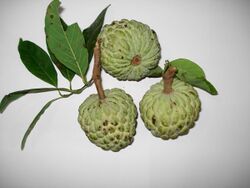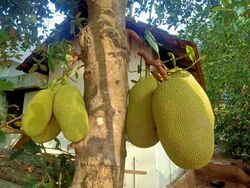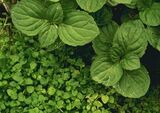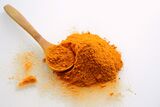Food product drug
Topic: Unsolved
 From HandWiki - Reading time: 8 min
From HandWiki - Reading time: 8 min
Food product drug is a term used to describe foods that have potential therapeutic effects. This beneficial effect is caused by containing one or more pharmacologically active ingredients. Food product drugs include medicinal foods, dietary fibres, herbs and fungus. In contrary to medical foods, functional foods and nutraceuticals, food product drugs are generally not regulated and can be easily accessed by the public. The most common category is medicinal foods, which includes berries and soy. Some fruits that have promising effects are generally rarer, like custard apples, breadfruits and jackfruits. Dietary fibres can also be considered as food product drugs because both soluble and insoluble fibres provide health benefits to human. In different cultures, herbs are used extensively as drugs too, for instance cinnamon, peppermints and turmeric. Mushroom being a food product drug, is investigated more extensively and statins are developed from it.
Medicinal foods
Food is getting more attentions towards its therapeutic effects in recent years. Increasing cases of studies had shown the effect and potential health benefits of plants and foods, most of which contains pharmacologically active agents similar to those used in medicines, while some are relatively new to modern knowledge.
Common medicinal foods
Even food that is as common as berries and as omnipresent as soy beans can have therapeutic effects. Berries contain a lot of antioxidants and flavonoids[1], which is found to decrease the risk of heart diseases. While soy isoflavones, a type of phytochemical, can reduce blood ‘bad cholesterol’ and reduce the symptoms of menopause like ease the rate of bone demineralisation[2]. Common food and drinks like leafy green and green tea are also been suggested to have therapeutic effects in human[3]. For more, please see superfoods.
Rare but promising medicinal foods
Annona squamosa Linn. (Custard apple)
Annona squamosa Linn. (Annonaceae) also known as custard apple, is used in India and other tropical countries, contains pharmacologically active agents like anonaine, aporphine, coryeline, isocorydine, norcorydine, and glaucine[4]. It is suggested that this fruit can be used as an anti-diabetic[5] and anti-tumor agent[6]. The seed oil of custard apple have Bullatacin, reported to be able to suppress H22 tumor cell lines, with surprisingly high efficacy, being 300 times strong that taxol, a current chemotherapy drug[7].
Its anti-diabetic effect is further supported by the an experiment done on rats. Blood glucose level is significantly dropped after administering extract of fruit peel to rats daily (250 mg/kg body weight) for 21 days[8].
Artocarpus altilis (Breadfruit)
Artocarpus altilis Parkinson Fosberg (Moraceae) also known as breadfruit, is used in the south west Asia, usually as a starchy food in diets, has been reported for being able to reduce muscle pains. As it contains geranylated flavones, a type of prenylated phenolic compounds, which has antioxidizing properties for easing the joint and muscle pain by having potent α-reductase inhibitory effect and superoxide anion-scavenging activity[9]. It can reduce the primary mediators of inflammations and thus lessen the pain reaction of the patient.
Artocarpus heterophyllus (Jackfruit)
Artocarpus heterophyllus Lam. (Moraceae) also known as Jackfruit, native in India and Malaysia it has a long history and widely developed treatments in several tribal cultures like Ayurvedic and Unani medicines[10], all parts of this plant had been documented in their culture as plants, for example used in prevention of bile over production, strength the body and increases virility[11]. Recently, it is found to have artocarpesin[11], potentially have effect of reducing inflammation by decreasing the secretion of NOx and prostaglandins, which is common in obese patients[12]. Jacalin is also noticed in its seed oils[13], which has anti-carcinogenic effects and are suggested to be important for studying the increase immune response for patients have AIDs[12].
Dietary Fibres
Dietary fibres are a group of plant food, most specific types of carbohydrates, which cannot be digested by human enzymes. Dietary fibre is found in numerous edible plant foods, such as vegetables, grains, lentils, cereals, nuts, and dried peas. Fibre is classified into various categories based on the physical properties of the individual fibre.[14][15] Solubility is one of the main physical features considered in grouping dietary fibre, and this way, fibre can be soluble or insoluble[15]. Dietary fibre is made up of non-starch polysaccharides and other essential plant constituents like cellulose, inulin, chitins, oligosaccharides, beta-glucans, pectins, resistant starch, and dextrins. Until the late 20th century, some of these plant components were not regarded as fibre; only lignin and polysaccharides were believed to satisfy the identification of dietary fibre. But by the early 21st century, components included in defining a dietary fibres expanded to include oligosaccharides and resistant starch[15].
Soluble and insoluble fibres
Fibres are categorised into soluble and insoluble fibres by using physical properties. Soluble fibre is those fibre that dissolves in water to form gel-like material and can be easily fermented in the large intestines into active physiological by-products like short-chain fatty acids released in the large intestine by digestive bacteria[16]. The main functions of soluble fibres include supporting the growth of mild bacteria that assist in maintaining the health of the digestive tract, reduce the speed food takes to pass via the stomach and enter the ileum to slow assimilation of glucose into bloodstream and minimise absorption of cholesterol by attaching to it in the digestive tract[16]. Sources of soluble dietary fibre include food such as beans, barley, and fruits[16]. Insoluble fibres, on the other hand, fibres do not dissolve in water when ingested into the gut. The primary function of insoluble fibre is bulking.. Bulking fibre absorbs water from the food material in the gut as it moves through, thus making defecation much easier[16] . Foods that act as sources of insoluble fibres include vegetables (zucchini, nopal, green beans, and celery), nuts, whole-meal bread, and wheat bran.
Herbs
Plants have provided therapeutic functions since ancient civilisation. Herbals are typically plant materials that are consumed as food, but usually as a condiment and sometimes for their additional medicinal value in the diet [17]. Herbs are naturally grown plant materials, however that does not mean they are safe. Some herbals can interact with medicines. Herbs that are used as food are of various categories and kinds. Herbs can be obtained from leaves, stems, seeds, roots, or flowers of a plant. Functions of herbs used as food are sometimes unique to that particular herb; therefore, to understand the functions of herbs in the diet, it is important to discuss each and every herb.
Cinnamon
One of the popular herb used as a spice is cinnamon. Cinnamon can found in various recipes and baked food products. Some studies suggested that cinnamon maybe able to reduce cholesterol triglycerides in human blood, as well as lowering blood glucose, but some showed there are no significant effect[18].
Peppermint
Peppermint is another popular food product with possible health functions. The oil component of the herb is often associated with possible medicinal use. Some studies suggested that peppermint oil can be applied to minimise pain in irritable bowel syndrome (IBS), nausea etc.[19]
Turmeric
Turmeric, which is a popular food product, contains multiple compounds that have medicinal use, particularly the compound curcumin.[20] Curcumin and other chemicals in turmeric may possess anti-inflammatory features. Additionally, some researchers have suggested that turmeric maybe effective for hay fever, depression, high level of cholesterol, osteoarthritis etc.[20]
Medicinal fungus
In China and other East Asian countries, medicinal mushrooms are commonly used for promotion of health and longevity. Fungal glycans can be found in some edible mushrooms, which have beneficial effects such as anti-aging and anti-oxidation. In 1980s, Chinese Food and Drug Administration approved eight edible mushrooms for clinically use.[21]
Statins from mushrooms
Oyster mushrooms have the highest concentration of lovastatin among all mushrooms. Lovastatin is now commonly prescribed for lowering patients low density lipoproteins (LDL)[22]. Lovastatin is so effective that just using 80mg can reduce patient cholesterol by about 40-45%.[23] Although most of the current statins are not extracted by fungus, the first statin ever created is isolated from a mushroom, Penicillium citrinum, called mevastatin,[24] which then now developed as a class of medicines.
References
- ↑ Skrovankova, Sona; Sumczynski, Daniela; Mlcek, Jiri; Jurikova, Tunde; Sochor, Jiri (2015-10-16). "Bioactive Compounds and Antioxidant Activity in Different Types of Berries". International Journal of Molecular Sciences 16 (10): 24673–24706. doi:10.3390/ijms161024673. ISSN 1422-0067. PMID 26501271. PMC 4632771. https://www.ncbi.nlm.nih.gov/pubmed/26501271.
- ↑ "Is Resveratrol a Panacea? — Evidence Shows It May Protect Against Many Diseases". https://www.todaysdietitian.com/newarchives/011012p46.shtml.
- ↑ "Superfoods: Health benefits, uses, and risks" (in en). https://www.medicalnewstoday.com/articles/303079.
- ↑ Pandey N, Barve D. Phytochemical and pharmacological review on Annona squamosa Linn. International Journal of Research in Pharmaceutical and Biomedical Sciences. 2011;2(4):1404–1412.
- ↑ Shirwaikar, Annie; Rajendran, K; Dinesh Kumar, C; Bodla, Ramgopal (2004). "Antidiabetic activity of aqueous leaf extract of Annona squamosa in streptozotocin–nicotinamide type 2 diabetic rats". Journal of Ethnopharmacology 91 (1): 171–175. doi:10.1016/j.jep.2003.12.017. ISSN 0378-8741. http://dx.doi.org/10.1016/j.jep.2003.12.017.
- ↑ Cheema PS, Dixit RS, Koshi T, Perti SL. Insecticidal properties of the seed oil of Annona squamosa L. Journal of Scientific and Industrial Research. 1985;17:132–136.
- ↑ Liaw, Chih-Chuang; Wu, Tung-Ying; Chang, Fang-Rong; Wu, Yang-Chang (2010-06-24). "Historic Perspectives on Annonaceous Acetogenins from the Chemical Bench to Preclinical Trials". Planta Medica 76 (13): 1390–1404. doi:10.1055/s-0030-1250006. ISSN 0032-0943. http://dx.doi.org/10.1055/s-0030-1250006.
- ↑ ., Ashok Sharma; ., Ashish K. Sharma; ., Tara Chand; ., Manoj Khardiya; ., Suresh Agarwal (2013-11-15). "Preliminary Phytochemical Screening of Fruit Peel Extracts of Annona Squamosa Linn.". Journal of Current Pharma Research 4 (1): 1038–1043. doi:10.33786/jcpr.2013.v04i01.001. ISSN 2230-7834. http://dx.doi.org/10.33786/jcpr.2013.v04i01.001.
- ↑ Lan, Wen-Chun; Tzeng, Cheng-Wei; Lin, Chun-Ching; Yen, Feng-Lin; Ko, Horng-Huey (2013). "Prenylated flavonoids from Artocarpus altilis: Antioxidant activities and inhibitory effects on melanin production". Phytochemistry 89: 78–88. doi:10.1016/j.phytochem.2013.01.011. ISSN 0031-9422. http://dx.doi.org/10.1016/j.phytochem.2013.01.011.
- ↑ Saxena, Alok; Bawa, A.S.; Raju, P.S. (2009). "Phytochemical changes in fresh-cut jackfruit (Artocarpus heterophyllus L.) bulbs during modified atmosphere storage". Food Chemistry 115 (4): 1443–1449. doi:10.1016/j.foodchem.2009.01.080. ISSN 0308-8146. http://dx.doi.org/10.1016/j.foodchem.2009.01.080.
- ↑ 11.0 11.1 Baliga, Manjeshwar Shrinath; Shivashankara, Arnadi Ramachandrayya; Haniadka, Raghavendra; Dsouza, Jerome; Bhat, Harshith P. (2011). "Phytochemistry, nutritional and pharmacological properties of Artocarpus heterophyllus Lam (jackfruit): A review". Food Research International 44 (7): 1800–1811. doi:10.1016/j.foodres.2011.02.035. ISSN 0963-9969. http://dx.doi.org/10.1016/j.foodres.2011.02.035.
- ↑ 12.0 12.1 Pereira-da-Silva, Gabriela; Moreno, Andréa N.; Marques, Fabiana; Oliver, Constance; Célia Jamur, Maria; Panunto-Castelo, Ademilson; Roque-Barreira, Maria Cristina (2006). "Neutrophil activation induced by the lectin KM+ involves binding to CXCR2". Biochimica et Biophysica Acta (BBA) - General Subjects 1760 (1): 86–94. doi:10.1016/j.bbagen.2005.09.011. ISSN 0304-4165. http://dx.doi.org/10.1016/j.bbagen.2005.09.011.
- ↑ Jagtap, U.B.; Bapat, V.A. (2010). "Artocarpus: A review of its traditional uses, phytochemistry and pharmacology". Journal of Ethnopharmacology 129 (2): 142–166. doi:10.1016/j.jep.2010.03.031. ISSN 0378-8741. http://dx.doi.org/10.1016/j.jep.2010.03.031.
- ↑ "Human nutrition - Essential nutrients" (in en). https://www.britannica.com/science/human-nutrition.
- ↑ 15.0 15.1 15.2 "Dietary fibre" (in en). https://www.britannica.com/science/dietary-fiber.
- ↑ 16.0 16.1 16.2 16.3 "Feeling Good with Fiber: A quick reference guide to dietary fiber" (in en-US). 2013-12-31. https://foodinsight.org/feeling-good-with-fiber-a-quick-reference-guide-to-dietary-fiber/.
- ↑ "A guide to herbal remedies: MedlinePlus Medical Encyclopedia" (in en). https://medlineplus.gov/ency/patientinstructions/000868.htm.
- ↑ "Can Taking Cinnamon Supplements Lower Your Blood Sugar?" (in en-US). 2016-10-04. https://health.clevelandclinic.org/can-taking-cinnamon-lower-your-blood-sugar/.
- ↑ "Benefits of Peppermint Oil: Uses, Side Effects & Research" (in en). https://www.healthline.com/health/benefits-of-peppermint-oil.
- ↑ 20.0 20.1 "Turmeric: Uses, Side Effects, Interactions, Dosage, and Warning". https://www.webmd.com/vitamins/ai/ingredientmono-662/turmeric.
- ↑ Yang, Dandan; Zhou, Zijing; Zhang, Lijuan (2019-01-01), Zhang, Lijuan, ed., "Chapter Eight - An overview of fungal glycan-based therapeutics" (in en), Progress in Molecular Biology and Translational Science, Glycans and Glycosaminoglycans as Clinical Biomarkers and Therapeutics - Part B (Academic Press) 163: pp. 135–163, http://www.sciencedirect.com/science/article/pii/S1877117319300225, retrieved 2020-04-23
- ↑ "ACC-AHA guideline on statin use saves lives and costs". PharmacoEconomics & Outcomes News 782 (1): 7–7. doi:10.1007/s40274-017-4138-x. ISSN 1173-5503. http://dx.doi.org/10.1007/s40274-017-4138-x.
- ↑ Shepherd, James; Hunninghake, Donald B.; Barter, Philip; McKenney, James M.; Hutchinson, Howard G.. "Guidelines for Lowering Lipids to Reduce Coronary Artery Disease Risk: A Comparison of Rosuvastatin with Atorvastatin, Pravastatin, and Simvastatin for Achieving Lipid-Lowering Goals". Atherosclerosis Supplements 5 (3): 115–123. doi:10.1016/j.atherosclerosissup.2004.08.032. ISSN 1567-5688. http://dx.doi.org/10.1016/j.atherosclerosissup.2004.08.032.
- ↑ Bellosta, Stefano; Paoletti, Rodolfo; Corsini, Alberto (2002), "History and development of HMG-CoA reductase inhibitors", HMG-CoA Reductase Inhibitors (Birkhäuser Basel): pp. 1–17, ISBN 978-3-0348-9451-7, http://dx.doi.org/10.1007/978-3-0348-8135-7_1, retrieved 2020-04-23
 KSF
KSF






